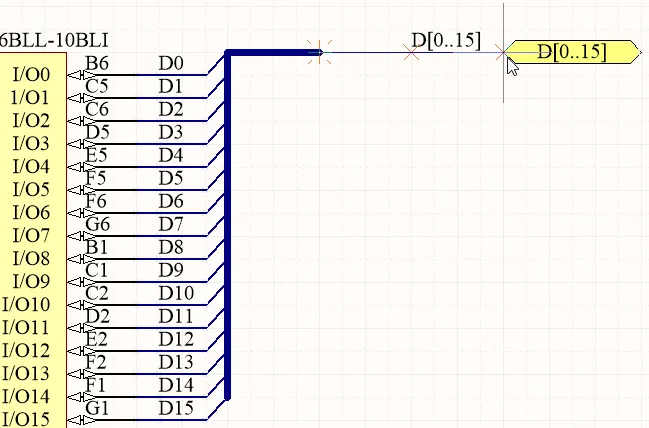Applied Parameters: ContextSensitive=True
Summary
This command is used to place a Bus object onto the active document. A bus is an electrical design primitive. It is a polyline object that represents a multi-wire connection.
For detailed information about this object type, see
Bus.
Access
This command is available in both Schematic and Schematic Library Editors, but only when right-clicking over an existing placed bus object, and choosing the Bus command from the context menu.
Use
After launching the command, the cursor will change to a cross-hair and you will enter bus placement mode. Placement is made by performing the following sequence of actions:
- Click or press Enter to anchor the starting point for the bus.
- Position the cursor and click or press Enter to anchor a series of vertex points that define the shape of the bus.
- After placing the final vertex point, right-click or press Esc to complete placement of the bus.
- Continue placing further bus objects, or right-click or press Esc to exit placement mode.
- Use the Backspace or Delete keys to remove the last bus segment placed.
Press the
Tab key during placement to access the
Bus dialog, from where properties for the bus can be changed on-the-fly.
Placement Modes
When placing a bus there are 3 'manual' placement modes, 2 of which have Start and End sub-modes. The mode specifies how corners are created when placing buses and the angles at which buses can be placed. During placement:
- Press Shift+Spacebar to cycle through the 90 Degree, 45 Degree and Any Angle modes.
- While in the 90 Degree or 45 Degree mode (known as true orthogonal modes), press Spacebar to cycle between the Start and End sub-modes.
- During placement, the current placement mode is displayed in the Status bar. You can change modes at any time during bus placement.
- In modes other than Any Angle, the line segment attached to the cursor is a look ahead segment. The segment you are actually placing precedes this look ahead segment.
 45 degree mode
45 degree mode
 90 degree mode
90 degree mode
 Any angle mode
Any angle mode
Press Shift+Spacebar to cycle through the different placement modes.
There is also an
Auto Wire mode, which can be used to route quickly from the previous segment end, to the point where the cursor is clicked, using the
Point to Point Router. The path of the route will be the most efficient possible, while avoiding existing placed objects on the sheet. Press
Tab while in this mode to configure applicable options in the
Point to Point Router Options dialog.
Guided wiring of a Bus
Schematics have a definable electrical grid that makes it easy to define electrical connections between objects. As you are placing a bus, when the bus falls within the electrical grid range of another electrical object the cursor will snap to the fixed object and a Hot Spot (red cross) will appear.

Hot Spot (red cross).
The Hot Spot guides you to where a valid connection can be made and automatically snaps the cursor to electrical connection points.
The electrical grid can be defined on the Sheet Options tab of the Document Options dialog (Design » Document Options). It is recommended that you set the electrical grid to be slightly smaller than the current snap grid, or it becomes difficult to position electrical objects one snap grid apart.
Tips
- For information on how a placed bus object can be modified graphically, directly in the workspace, see Graphical Editing.
- A T-junction in a bus is automatically connected by a junction (Compiler-Generated Juntion). If the Break Wires At Autojunctions option is enabled, on the Schematic - General page of the Preferences dialog, an existing bus segment will be broken into two at the point where an autojunction is inserted. For example, when making a T-Junction, the perpendicular bus segment will be broken into two segments, one each side of the junction. With this option disabled, the bus segment will remain unbroken at the junction.
- While attributes can be modified during placement (Tab to bring up the associated properties dialog), bear in mind that these will become the default settings for further placement unless the Permanent option on the Schematic – Default Primitives page of the Preferences dialog is enabled. When this option is enabled, changes made will affect only the object being placed and subsequent objects placed during the same placement session.
